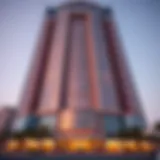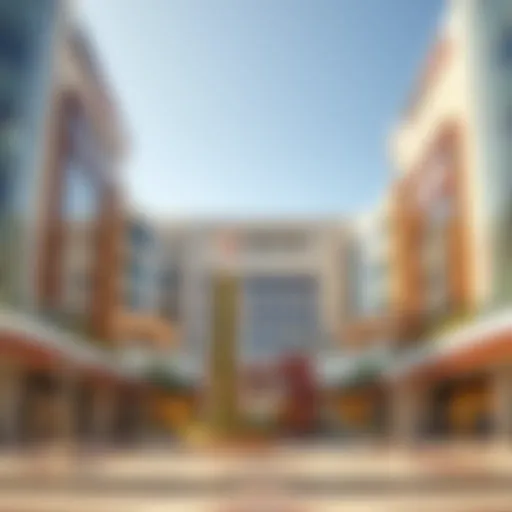Exploring the Juma Al Majid Building: Architecture and Impact
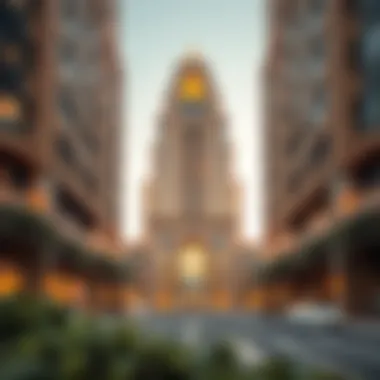
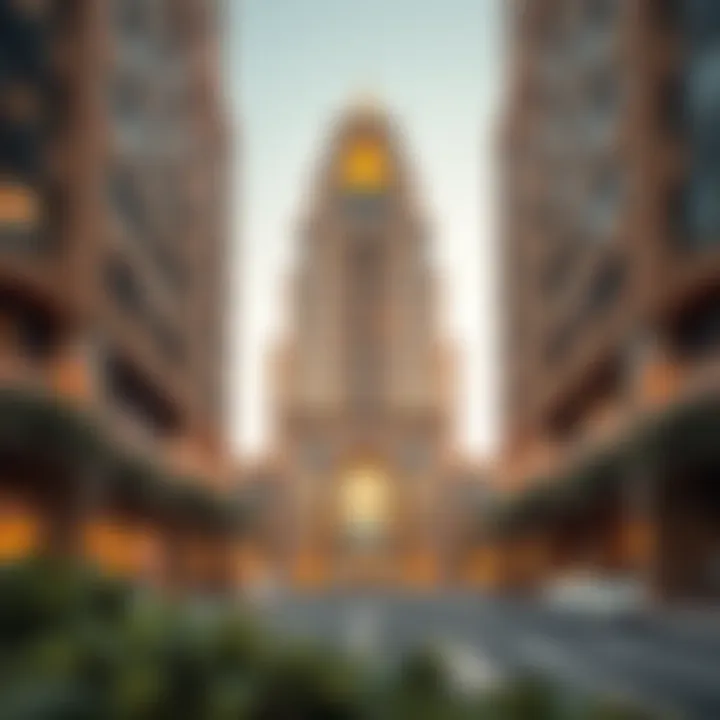
Intro
Nestled in the heart of Deira, the Juma Al Majid Building isn’t just another structure overshadowed by Dubai’s soaring skyscrapers. It stands out as a cultural beacon and a testament to modern architectural ingenuity. It represents an intersection where history intertwines with today's bustling commercial activities. As Dubai continues its rapid expansion, understanding the nuances of such landmarks becomes crucial, especially for those looking to invest or delve into the real estate market.
In this article, we will explore several aspects of the Juma Al Majid Building—from its architectural design to its role in the community. We will discuss current trends in the Dubai real estate market, highlight the burgeoning areas that investors should keep an eye on, and provide practical guidance for potential buyers and renters navigating this evolving city. The ultimate aim here is to provide a comprehensive overview that appeals to anyone with an interest in the dynamics of Dubai's real estate landscape.
Market Insights
Current Trends in Dubai Real Estate
Dubai's real estate market has become a compelling arena for local and foreign investors alike. With property prices fluctuating and an increasing influx of expatriates, the dynamics here are ever-changing. A few trends have emerged that underline the direction in which the market is heading:
- Sustainability and Eco-Design: Increasingly, properties that emphasize sustainable living and eco-friendly designs are attracting more attention. Developers are incorporating green spaces and energy-efficient resources to appeal to environmentally-conscious buyers.
- Community-Centric Developments: There’s a noticeable shift towards designing spaces that foster community engagement. This is where buildings like Juma Al Majid stand out, as they not only offer spaces for business but also cultivate social interaction.
- Shift to Suburbs: As urban areas get more congested, many are opting for properties in the suburbs. Areas like Jumeirah Village Circle and Dubai Hills Estate are witnessing an uptick in interest, giving buyers an option for larger spaces while remaining connected to the city center.
Emerging Areas and Investment Hotspots
With the continuous development taking place in Dubai, certain areas have emerged as investment hotspots. These neighborhoods are not only experiencing rapid growth but also promise significant returns on investment. Some noteworthy ones include:
- Dubai Marina: Known for its vibrant lifestyle and scenic views, this area is a favorite among expatriates seeking a modern living environment.
- Business Bay: Home to a plethora of businesses, this district combines lush greenery with high-rises, making it perfect for both residential and commercial investments.
- Al Quoz: Once considered an industrial zone, it is now transforming into an art and cultural hub, attracting both artists and investors alike.
"Investing in real estate is not just about property. It’s about positioning yourself in a developing market with untapped potential."
In the grand scheme of things, the Juma Al Majid Building epitomizes this intersection of traditional values and modern investment opportunities. Thus, understanding its role amid these evolving trends can provide invaluable insight for those venturing into Dubai’s property market.
Prolusion
The Juma Al Majid Building in Deira is more than just a structure; it’s a testament to the evolution of Dubai's architectural and social landscape. As the buzzing heart of this bustling city, the building encapsulates a rich tapestry of history and functionality, making it vital not merely to locals but also to a broader audience, including real estate investors, expatriates, and cultural enthusiasts.
Understanding the significance of this building is pivotal for anyone looking to navigate the complex waters of Dubai's real estate market or for those simply intrigued by architectural marvels. The Juma Al Majid Building stands as a bridge between the past and present, offering insights into how Dubai has transformed from quaint trading routes to a modern metropolis.
Exploring this building also highlights several key elements. Firstly, it showcases the impressive design principles that marry traditional and contemporary styles. A keen appreciation of these elements can benefit investors looking to grasp the architectural language that resonates within the community. Secondly, delving into the building’s functionality reveals how it serves as a fulcrum for commercial activities and cultural engagement, thereby impacting local economies.
Moreover, upcoming sections of this article will venture into the social impact of the building, its stature in the local heritage, and its potential future as a pillar of ongoing urban development. Whether you're eyeing it from an investment standpoint or you’re eager to understand its cultural resonance, this article promises a comprehensive overview that caters to your curiosity and aspirations.
As we peel back the layers of the Juma Al Majid Building, the multi-dimensional perspective it provides will be instrumental for both real estate enthusiasts and casual observers alike.
Historical Context of Deira
Understanding the historical backdrop of Deira is crucial for comprehending the significance of the Juma Al Majid Building. Deira, often regarded as the heart of Dubai, has undergone dramatic transformations from a modest trading hub to a bustling modern urban center. This metamorphosis warrants attention as each phase of development has been pivotal in shaping the architectural and cultural landscape we observe today.
Evolution of Deira's Urban Fabric
Deira's urban fabric has evolved significantly over the decades. Originally, Deira was a small fishing village surrounded by mangroves, which later attracted merchants due to its strategic positioning along the creek. Trade flourished, leading to the establishment of traditional souks—like the renowned Gold Souk and Spice Souk—which are still vital elements today. This organic growth of Deira turned it into a melting pot of cultures, fostering a unique sense of identity. Notably, the infusion of Persian and Indian influences can still be seen in the architectural styles and the diverse communities.
The post-1970s era marked a turning point, as urban planning began prioritizing infrastructure. Skyscrapers started dotting the skyline, and the cramped spaces transformed into a more structured urban landscape. While the essence of Deira’s vibrant bazaars remained intact, modern structures like the Juma Al Majid Building emerged alongside them, blending traditional with contemporary.
Significance in Dubai’s Development
Deira's significance extends beyond just being a locale; it's a cornerstone in Dubai's embryonic journey to becoming a global city. Historically, it served as Dubai's primary marketplace, establishing lucrative trade routes that brought prosperity to the region. Furthermore, as Dubai's ambitions grew in the late 20th century, Deira embodied the economic pulse of the emirati city.
In terms of real estate, Deira represents a juxtaposition of legacy and new beginnings. As the city expanded, Deira attracted significant investment. The steady rise of commercial buildings, including the Juma Al Majid Building, reflects broader economic trends. This area gradually became a prime investment spot, directly boosting local businesses and enabling international entities to flourish within its boundaries.
Today, Deira is not merely a section of Dubai; it carries the weight of its historical context into its present narratives. The progress reflected in the Juma Al Majid Building illustrates how local history can inform modern architectural expression. Investors, expatriates, and home buyers looking into Deira must consider this historical interplay as it offers deeper insights into the value of properties and the socio-economic dynamics at play.
Architectural Overview of Juma Al Majid Building
The Juma Al Majid Building is more than just a structure; it serves as a focal point of architectural innovation within the vibrant tapestry of Deira. This building offers a snapshot of both historical influence and modern aesthetics, making it essential to understand how it contributes to the overall narrative of Dubai's urban evolution. In the ever-changing landscape of architecture, this building encapsulates a blend of form and function, reflecting the cultural identity and ambitions of the Emirate.
Design Principles and Aesthetics
When delving into the design principles guiding the Juma Al Majid Building, one quickly notices the careful consideration given to integrating local culture into its form. The architects employed traditional Islamic motifs alongside modern lines, achieving a harmonious balance that resonates with both residents and visitors alike. This fusion resonates well with the ethos of Dubai; a city rooted in tradition while constantly looking toward the future.
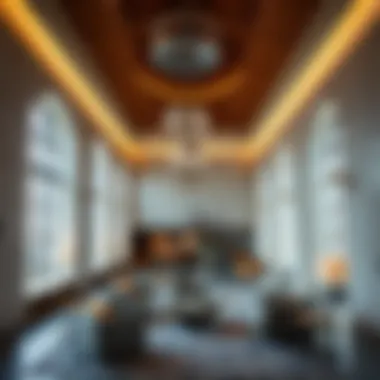
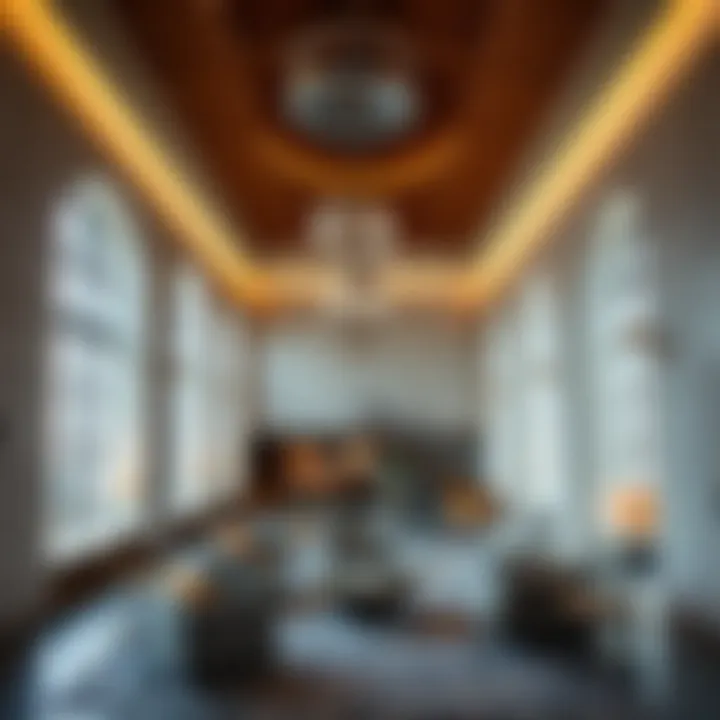
The aesthetic appeal of the building can be attributed to its exceptional facade, characterized by intricate geometric patterns and a striking use of glass. The vast windows not only invite natural light but also provide stunning views of the bustling streets below. Furthermore, colors and materials were meticulously chosen to reflect the local environment, from the sandy hues of the facade to the sleek metallic detaiils that catch the sunlight. Visitors often comment on the way the building seems to shimmer at different times throughout the day, an architectural dance of light and shadow.
"Architecture is a visual art, and the building speaks a language understood by the heart."
In sum, the design and aesthetics of the Juma Al Majid Building create a visual dialogue that captivates, and commands respect.
Materials and Construction Techniques
The construction of the Juma Al Majid Building reveals a judicious selection of materials that emphasize durability and local availability. Relying on traditional building materials like stone and marble, the architects also incorporated cutting-edge technologies that optimize sustainability.
For example, the structural integrity relies on reinforced concrete, ensuring that the building withstands the tests of time and elements while stylishly maintaining its form. The use of locally sourced materials not only reduces the carbon footprint but also supports local economies.
Additionally, modern construction techniques play a pivotal role in ensuring an efficient build. The integration of prefabricated elements has drastically reduced construction time without compromising quality. High-performance glazing was used to enhance energy efficiency, allowing for natural lighting while controlling heat gain, a key consideration in the hot desert climate of Dubai.
In summary, the materials and techniques employed in the Juma Al Majid Building serve not only to provide structure but also to ensure a lasting legacy that harmonizes with both its community and the environment.
Functionality and Usage
Understanding the functionality and usage of the Juma Al Majid Building is critical in painting a full picture of its role within Deira's vibrant landscape. This building is not just a physical structure; it embodies a blend of commercial opportunities and cultural significance that resonates deeply within the community. The way people interact with such spaces significantly influences the social fabric of the area.
Commercial Activities Within the Building
The Juma Al Majid Building serves as a hub for various commercial activities that contribute to the local economy. Occupying a prime position in Deira, it attracts businesses ranging from retail shops to professional services. You can find offices, showrooms, and even educational institutions operating within its premises. This variety not only amplifies the foot traffic in the region but also creates a sense of economic dynamism.
- Retail Spaces: The ground level is often bustling with shops showcasing a range of products that cater to both residents and tourists alike. This variety enhances the shopping experience, making it a one-stop destination for many.
- Business Services: Many businesses opt for office spaces in this building due to its strategic location, which provides easy access to potential clients and partners. The presence of such enterprises contributes to the overall business ecosystem of Deira.
- Educational Facilities: Recently, some areas have been repurposed to house institutions that focus on skill development and training. This reflects the shift towards enhancing local talent and echoes the broader educational initiatives of Dubai.
This commercial vibrancy further solidifies the importance of the Juma Al Majid Building, as it offers not just a place for transactions, but a community space where people connect and engage.
Cultural Significance and Community Engagement
The cultural significance of the Juma Al Majid Building extends beyond its physical structure. It acts as a cultural landmark, reflecting the rich heritage of the UAE while simultaneously embracing modernity. The building hosts various events that promote community engagement and foster an appreciation for Emirati culture.
- Cultural Events: Periodic festivals and exhibitions are often organized within the building, showcasing local crafts, music, and art. These events provide a platform for local artists to exhibit their work, which helps preserve and promote Emirati traditions.
- Community Programs: Workshops and seminars aimed at locals are regularly held, focusing on topics such as history, art, and sustainability. This engagement nurtures a sense of belonging and strengthens community ties.
- Heritage Showcases: The building regularly collaborates with cultural organizations to highlight Emirati heritage through displays and performances. This not only educates outsiders about local customs but also instills pride among residents.
In summary, the Juma Al Majid Building is more than a commercial space; it's a pillar of the community that fosters engagement and celebrates culture. Its role in Deira’s identity cannot be understated, as it creates a vibrant atmosphere that encourages both economic activity and social cohesion.
The Building's Impact on Local Real Estate
The Juma Al Majid Building is not just a structure; it serves as a cornerstone in understanding the broader real estate market in Deira. This section aims to elucidate how this building influences local property dynamics, including both its commercial viability and cultural relevance. The intersection of these aspects holds immense importance for investors and residents alike, as it shapes the economic fabric of the neighborhood.
Current Market Trends in Deira
When engaging with real estate, recognizing current market trends proves vital. Deira, with its eclectic mix of commerce and culture, showcases a real estate scene that's both vibrant and intricate. Over the past few years, the market in Deira has seen a notable revival fueled by economic diversification and infrastructural developments. This rejuvenation is largely attributed to strategic initiatives by the Dubai government, enhancing connectivity and accessibility across the area. For example, the expansion of the Dubai Metro has significantly improved transport links, encouraging both residents and businesses to look towards Deira for new opportunities.
Recent statistics indicate a gradual increase in property values across various sectors, particularly due to the influx of expatriates and local businesses setting up shop in the area. Favorable rental yields have drawn the interest of not only seasoned investors but also newcomers exploring possibilities. With Dubai's tourism sector steady on the rise, properties near the Juma Al Majid Building have become more attractive due to their proximity to key attractions and facilities, making them coveted choices for both living and investment.
Investment Opportunities and Risks
As enticing as the landscape may appear, potential investors should tread carefully, weighing the opportunities against possible risks. Amid the optimistic outlook for Deira's real estate, certain factors warrant critical scrutiny. For instance, while the Juma Al Majid Building enjoys a strategic location, broader economic shifts can impact occupancy rates and, by extension, rental income.
When contemplating investment, it’s essential to evaluate various aspects:
- Market Competition: Deira is bustling with activity; however, this translates to substantial competition among properties. Investors should analyze how the Juma Al Majid Building positions itself against other local landmarks and whether it can maintain a competitive edge.
- Legal Considerations: Property regulations in Dubai are intricate and can change rapidly. Investors should stay informed of regulatory shifts that might affect ownership and operational processes.
- Economic Fluctuations: Global events and local economic conditions can steer the real estate market in unpredictable directions. A downturn in tourism, for instance, could detrimentally affect rental incomes in prime areas.
While the path seems promising, prudence is key. Thorough market research combined with an understanding of local nuances will equip investors with the necessary insights to make informed decisions. Balancing the potential risks against the alluring prospects of the Juma Al Majid Building can reveal compelling avenues for growth in the local real estate landscape.
By keeping an ear to the ground regarding current trends and potential pitfalls, both seasoned investors and those venturing into the market can adapt strategies for sustained success.
Comparative Analysis with Other Landmark Buildings
In examining the Juma Al Majid Building, it is essential to place it alongside other notable structures in Dubai and beyond. This comparative analysis provides valuable insights into architectural styles, functionalities, and cultural contexts. By contrasting the unique attributes of the Juma Al Majid Building with those of other landmark buildings, one can better appreciate its intricacies. Moreover, understanding similarities and differences contextualizes the building within the broader urban tapestry of Dubai, which is a hotbed of architectural innovation.

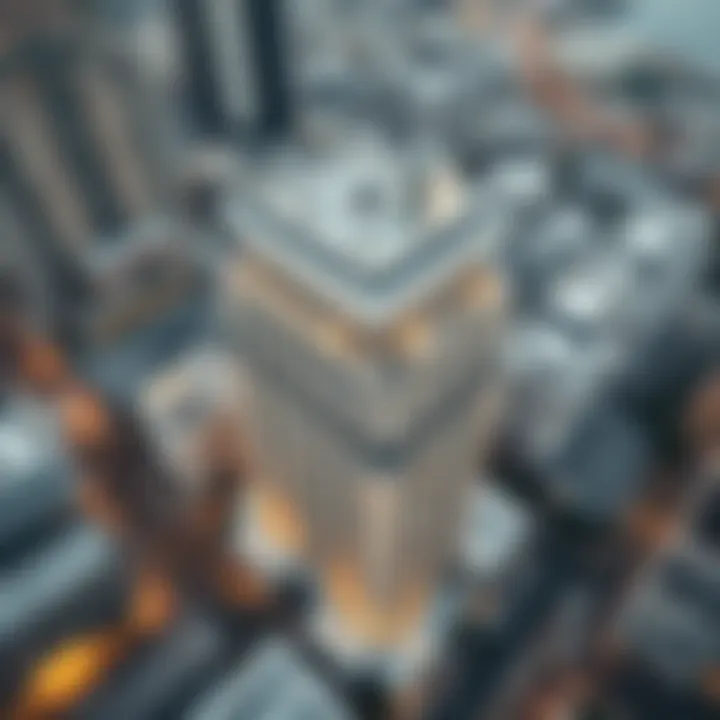
Similarities and Differences
When looking at landmark buildings in Dubai, such as the Burj Khalifa and the Dubai Opera, certain parallels emerge, yet they offer distinctly different narratives. For instance:
- Architectural Harmony: Both the Juma Al Majid Building and the Burj Khalifa emphasize grandeur, although the styles diverge significantly. The former leans towards Islamic aesthetics, showcasing intricate designs and motifs, while the latter embodies a modern skyscraper silhouette that speaks to contemporary engineering.
- Cultural Significance: All these buildings serve as more than mere structures; they symbolize aspirations and dreams of the emirate. While the Burj Khalifa suggests futuristic vistas, the Juma Al Majid Building roots itself in the cultural and social narratives of Emirati heritage, making it a focal point for community activities.
- Usage Patterns: Each landmark serves different functions within the urban setting. The Juma Al Majid Building is a commercial hub with rich cultural engagements, while Dubai Opera is dedicated to performing arts. This diversification of purpose highlights the dynamic nature of modern Dubai where buildings are designed to fulfill multiple roles.
Despite these similarities, several differences set the Juma Al Majid Building apart, particularly in its community-focused approach. Unlike the skyscraper-type designs of Burj Khalifa, which often cater to high-end tourism, the Juma Al Majid Building plays a pivotal role in community engagement and cultural representation.
Relevance to Dubai's Architectural Diversity
Dubai is a melting pot of architectural styles, and the Juma Al Majid Building is an embodiment of this diversity. The city’s skyline is punctuated with structures reflecting various influences—from ultramodern designs to traditional Islamic architecture. The prominence of the Juma Al Majid Building within this landscape speaks to a balanced narrative of innovation and tradition.
- Cultural Representation: The building serves as a canvas showcasing the Emirati culture through design and function. By integrating local traditions with contemporary needs, it contributes to the architectural dialogue of the city, encouraging a sense of identity and belonging among residents and visitors alike.
- Challenges and Opportunities: In the face of rapid urbanization, preserving the unique traits of landmarks like the Juma Al Majid Building is crucial. By advocating for such buildings, stakeholders can ensure that the essence of local culture is interwoven with the progress of modernity.
- Tourism and Education: As a focal point for cultural events, the Juma Al Majid Building attracts tourists, thereby enhancing its relevance as a landmark. Visitors can learn about the rich history of Dubai while appreciating its evolution through architecture.
The Role of Juma Al Majid in Promoting Local Culture
The Juma Al Majid Building serves more than just a physical structure; it's a compass guiding visitors through the rich cultural tapestry of the Emirates. This landmark emphasizes the importance of integrating local traditions and contemporary influences. In a city like Dubai, known for its rapid evolution, it stands out by promoting Emirati culture with sincerity and depth.
Cultural engagement is vital for a community's identity. Juma Al Majid encapsulates this essence by being a hub for various cultural activities that showcase local traditions and arts. It plays a strategic role in hosting events that promote an appreciation for Emirati heritage, making it a cornerstone for both residents and foreigners who wish to immerse themselves in the UAE’s vibrant culture.
"Cultural buildings like the Juma Al Majid serve as gateways, revealing the heart of the community and fostering connections among diverse groups."
Cultural Events and Activities
Throughout the year, the Juma Al Majid Building arranges numerous cultural events and activities that draw in people from all walks of life. These is not just ordinary events; they are experiences that resonate deeply with participants. From art exhibitions showcasing local artists to workshops on traditional crafts, the activities provide a platform for dialogue and learning.
- Art Exhibitions: Featuring both established and emerging local artists, these exhibitions allow for a display of traditional and contemporary art forms.
- Workshops: Regular workshops focus on traditional crafts, such as calligraphy and pottery, where participants can learn and appreciate the skills involved.
- Cultural Festivals: Celebrating national holidays and important cultural milestones, these festivals include folk music, dance performances, and culinary showcases, providing an immersive experience of Emirati traditions.
By engaging in these activities, Juma Al Majid helps foster a sense of pride among Emiratis while educating expatriates and tourists about the nuances of local culture. This interaction creates a mosaic of shared experiences that strengthens community ties and enhances cultural appreciation.
Showcasing Emirati Heritage
At the very core of the Juma Al Majid Building lies the effort to showcase Emirati heritage effectively. The architecture itself serves as a vessel for storytelling, blending contemporary design with traditional motifs, which invites observers to reflect on the UAE's history and values.
The building hosts various exhibits that feature historical artifacts and narratives essential to understanding the Emirati identity. Through curated displays, visitors gain insights into the past, from ancient trade routes to the discovery of oil, emphasizing how these elements shape modern society.
In addition, collaborations with local artists and historians ensure that the content presented remains authentic and relevant. The initiatives often extend beyond mere display, involving interactive elements that encourage participation. This can take the form of re-enactments, storytelling sessions, or guided tours that deepen the connection to our heritage.
- Educational Programs: Targeted at schools and youth organizations, these programs are designed to instill cultural knowledge among younger generations.
- Collaborative Projects: Partnerships with local museums and cultural organizations amplify the efforts to present a cohesive narrative of Emirati heritage.
- Community Involvement: Local residents are often invited to share their stories and experiences, further enriching the cultural fabric of the building.
By fostering such initiatives, Juma Al Majid doesn’t just preserve Emirati culture; it actively participates in its conversation and evolution, ensuring that the future of Emirati heritage is as vibrant as its past.
Sustainability Initiatives within the Building
The Juma Al Majid Building serves as a prime example of how sustainability is not just an afterthought in architectural design, but rather an integral part of its identity. In today's urban environment, the necessity for sustainable initiatives is undeniable, particularly in a rapidly developing region like Deira. This section explores how sustainability measures in this building elevate its significance, not just from an ecological standpoint but also as a beacon of innovative urban living.
Eco-Friendly Design Elements
At first glance, the sleek lines and modernity of the Juma Al Majid Building might mask its eco-friendly approach. Yet, as you delve deeper, you discover various design elements aimed at minimizing environmental impact. Large windows are strategically positioned to maximize natural light, reducing reliance on artificial lighting during the day.
Additionally, the use of local materials minimizes transportation emissions. This not only supports local businesses but also ensures that the aesthetic of the building resonates with its surroundings. Other features include green roofs and vertical gardens that enhance biodiversity and improve air quality.
Here are some noteworthy eco-friendly design aspects of the building:
- Natural ventilation: This design approach uses airflow to cool spaces, reducing the need for air conditioning.
- Rainwater harvesting systems: Collecting rainwater keeps the water usage efficient and supports landscape irrigation.
- Recyclable materials: A significant portion of materials used in the building is sourced from recyclable products, reflecting a commitment to sustainability.
“Sustainable architecture involves building not just for today, but for the future, ensuring the longevity of both the structure and the environment it inhabits.”
In summation, the Juma Al Majid exemplifies how thoughtful design can harmonize with nature, setting a standard in the region.
Energy Efficiency Measures


Energy efficiency in the Juma Al Majid Building extends beyond just the materials used; it informs the very mechanics of how the building operates. Energy-efficient systems have been implemented to reduce overall consumption without compromising functionality. For instance, LED lighting installations save significantly on electricity costs while offering high-quality illumination.
Moreover, advanced climate control systems adapt according to weather changes, ensuring power is not wasted. They automatically adjust heating and cooling based on occupancy levels, maximizing comfort while minimizing energy use.
Some key energy efficiency measures include:
- Smart building technologies: These systems allow for real-time monitoring and management of energy use throughout the building.
- Solar panels: Harnessing solar energy for power generation is a key initiative to reduce reliance on conventional energy sources.
- High-performance insulation: This prevents energy loss, keeping interiors comfortable without excessive heating or cooling.
Together, these energy efficiency measures not only serve the practical needs of occupants but also align with a broader commitment to environmental stewardship. As the building sector grapples with growing energy demands, the Juma Al Majid represents a step in the right direction for sustainable development in Deira.
Addressing sustainability is not merely a trend; it is an obligation for future climates and urban landscapes. By integrating these initiatives, the Juma Al Majid Building is paving the pathway for what urban living could look like in a world increasingly attentive to ecological impact.
Future Prospects for Juma Al Majid Building
The future of the Juma Al Majid Building holds both promise and potential for further shaping the landscape of Deira. As urban development continues to surge in Dubai, the building stands as a robust example of how architectural landmarks can evolve into multifaceted spaces that serve modern needs while respecting cultural heritage. The significance of exploring its future prospects lies in understanding the interplay of development trends, community needs, and sustainability initiatives, which can ultimately define the building's role in a rapidly changing environment.
Planned Developments and Renovations
In the coming years, plans are underway to enhance the Juma Al Majid Building to better cater to both current tenants and potential visitors. This includes renovations aimed at upgrading facilities to meet modern standards while remaining true to its architectural grace. Such upgrades may encompass:
- Technological Integration: Introducing smart building technologies that can optimize energy use while improving user experience. This may involve automated lighting systems, energy-efficient HVAC technologies, and improved safety features.
- Public Spaces Revitalization: Enhancing common areas, such as the atrium and surrounding courtyards, to create inviting spaces for visitors. Improvements could feature elements like vertical gardens and open-air workspaces that blend nature with urban life.
- Accessibility Improvements: Efforts to ensure that the building is fully accessible for everyone, including improvements to signage and pathways for people with disabilities.
- Cultural Programs Expansion: Increasing the scope of cultural initiatives and activities within the building to foster community engagement and promote local artists.
These planned developments indicate a commitment not only to maintaining the building's relevance but also to amplifying its role as a cultural hub in Deira.
Long-Term Impact on Deira
The long-term impact of the Juma Al Majid Building on Deira cannot be underestimated. As a landmark, it contributes significantly to the area's architectural identity and economic viability. Some anticipated effects include:
- Economic Boost: With a modernized space, the Juma Al Majid Building can attract diverse businesses and services, which can, in turn, generate jobs and stimulate local economies.
- Cultural Enrichment: By hosting more events and exhibitions, it can become a focal point for artistic expression, drawing both residents and tourists. This cultural influx has the potential to enhance community pride.
- Urban Revitalization Influence: The building's evolution may serve as a blueprint for neighboring structures to modernize and innovate. It can inspire a holistic approach to urban planning in Deira that balances historical value with contemporary demands.
- Increased Property Values: As the building becomes more attractive due to renovations and increased activities, surrounding real estate values are likely to rise, benefitting local homeowners and investors alike.
Overall, the future prospects of the Juma Al Majid Building reveal a landscape rich with opportunities that align with the growth trajectory of Deira. Real estate investors, expatriates, and homebuyers looking to capitalize on these developments will find a vibrant community that embraces both its history and its future.
Visitor Experience and Amenities
When it comes to visiting the Juma Al Majid Building, the experience is not just about a striking structure; it’s about the seamless integration of convenience and accessibility that makes it a prime location for locals and tourists alike. The interplay between amenities and transport links cultivates a hospitable environment, enhancing both the aesthetic and practical aspects of the building. This section aims to explore how these factors contribute to a rewarding visitor experience.
Accessibility and Transport Links
One of the noteworthy features of the Juma Al Majid Building is its strategic location, which offers robust transport links. Access to the building is facilitated by a myriad of transport options, making it easy for individuals to come and go.
- Metro Accessibility: The closest metro station, Al Rigga, is just a stone's throw away. This station, part of the Dubai Metro, connects visitors with various urban areas, effectively making the building accessible from multiple suburban and central points.
- Bus Services: Numerous bus routes run close to the site, allowing for an economical mode of transport. The bus services complement the metro options nicely, covering reaches that might be overlooked by the rail system.
- Taxi Services: Taxis are readily available and provide a flexible alternative for visitors, particularly those who prefer a more direct route. The efficient ride-sharing services available in Dubai also add a layer of convenience for tech-savvy travelers.
- Pedestrian Access: The surrounding streets are conducive to walkers, with well-maintained sidewalks guiding visitors straight to the entrance. This pedestrian-friendly design encourages foot traffic and makes for a pleasant arrival experience.
"Efficient transport links serve as arteries that facilitate the flow of people, connecting the vibrant cultures around Deira to the unique offerings of the Juma Al Majid Building."
The accessibility factors not only enhance visitor experience but also reflect on the building’s status in the community. As a hub of activity, the ease of transport directly affects footfall and engagement levels.
Amenities Within Close Proximity
The Juma Al Majid Building doesn't just stand alone; it is part of a lively community where visitors can find various amenities close at hand. This accessibility to nearby services elevates the visiting experience significantly.
- Dining Options: Around the building, a plethora of dining establishments range from local eateries serving authentic Emirati cuisine to internationally renowned fast food chains. Visitors can easily find a place to grab a bite after exploring the building.
- Shopping Facilities: A short stroll away, traditional markets and modern shopping centers bustle with activity. Visitors can browse for unique souvenirs or indulge in high-end shopping that Dubai is famous for.
- Cultural Spots: The rich tapestry of culture in Deira means that art galleries, small museums, and cultural centers are often just a hop and skip away. This activity enhances the cultural immersion for any visitor to the area, providing deeper insights into Emirati traditions.
- Accommodation: For those planning a longer stay, several hotels and serviced apartments offer lodging in the vicinity. This convenience means visitors can easily access the building multiple times during their visit.
By weaving together a network of amenities and efficient transport, the Juma Al Majid Building transforms from a mere architectural spectacle into a central fixture in the community, enhancing the overall visitor experience in countless ways.
Ending
The significance of the Juma Al Majid Building transcends its architectural elegance; it serves as a cornerstone for Deira's vibrant commercial and cultural milieu. Examining this building offers invaluable insights for real estate investors, expatriates, homebuyers, agents, and landlords alike. Its importance to the urban landscape is not merely about bricks and mortar; it captures the essence of a community that fuses tradition with modernity.
First, the commercial vitality of the Juma Al Majid Building is a testament to Dubai's evolution as a business hub. It showcases a variety of enterprises that support the local economy and create job opportunities. Prospective buyers and investors should take note of the bustling activity that thrives within its walls, an indicator of sustainable value for future investments.
Moreover, the cultural dimensions played out here cannot be overlooked. This building regularly hosts events that celebrate Emirati heritage, providing a platform for artists and cultural enthusiasts alike. The intertwining of commercial success with cultural significance demonstrates the multifaceted role this building plays in maintaining community ties — a feature that is especially attractive to real estate investors who are keen on properties that offer more than just financial returns.
In addition, sustainability practices in the building offer a glimpse into Dubai's commitment to eco-friendly urban development. The incorporation of energy-efficient systems and sustainable design elements not only fulfills current environmental standards but also enhances the marketability of the property.
In essence, understanding the Juma Al Majid Building goes beyond the physical structure itself; it embodies an essential facet of Dubai’s urban narrative. Recognizing its commercial impact, cultural relevance, and sustainability initiatives positions buyers and investors to make informed decisions in a fast-paced real estate market. Consequently, expertise in these areas becomes imperative in an increasingly competitive landscape.
So, whether you're a seasoned investor or a new homebuyer, keeping an eye on the Juma Al Majid Building could very well illuminate the path towards insightful decision-making in your real estate endeavors.








